Each year as awards season rolls around, there’s rarely a shortage of splendid cinematography to choose from. But this year’s crop seems unusually bountiful and impressively varied in look. Directors of photography have availed themselves of everything in their toolkit – at a time when film and digital camera options still remain available – to create the memorable images that are a large part of movie storytelling.
Here are the five nominees for this year’s Academy Award for best achievement in cinematography, to be handed out on Feb. 22:
Birdman, Cinematographer Emmanuel Lubezki
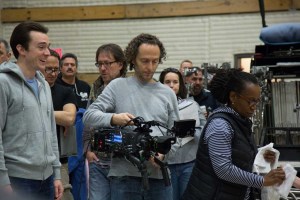
“Birdman was so experimental and so difficult that each step was like walking through a minefield,” said director of photography, Emmanuel (Chivo) Lubezki, who won last year’s cinematography Oscar for Gravity. The mind-boggling complexity of shooting the movie grew out of director-screenwriter Alejandro González Iñárritu’s audacious idea of making Birdman look as if it had been shot in just one take.
Though practically impossible to pull off as a single take, the film – a black comedy about a former movie superhero who is desperately trying to re-launch his moribund career by directing and starring in a Broadway play – consists of a continuous string of very long takes, which have been stitched together with some deft edits and a bit of CGI.
The use of the extended takes sparked the actors to perform as if they were in a play. “Because the takes were so long and complex and everybody had to be so concentrated and so focused, obviously no one wanted to be the one messing up a 20 minute shot,” he said. “This brought incredible energy into the movie. Not just the technical aspect but the emotional aspect.”
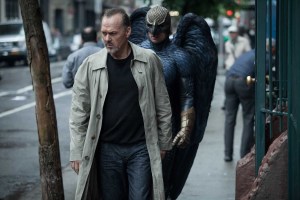
Meanwhile the DP and his crew were pushed to the limits, in terms of logistics, camera moves and lighting challenges. The camera was almost constantly moving, and Lubezki needed to be able to shoot 360 degrees. He almost entirely relied on existing or practical light sources without adding any of his own, and he had to stay with the actors for every beat.
Lubezki shot digitally with ARRI cameras, specifically the Alexa M and XT. The M was chosen for its light weight and small size which made it maneuverable for handheld lensing in tight quarters and for the sheer endurance of doing extended takes. The XT was mounted on Steadicam.
The film couldn’t haven’t been shot the way Iñárritu wanted without elaborate advance preparations. A little proxy stage was built in in Los Angeles at Sony Pictures. Rudiments of a set were assembled piece by piece while camera moves and blocking were being refined for each scene. “By the time we got to New York we were pretty clear about how the camera would be moving,” said the DP.
Mr. Turner, Cinematographer Dick Pope
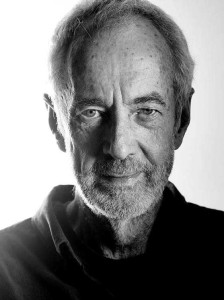
For Mr. Turner, director Mike Lee’s immersive film biography of the great 19th century English painter J.M.W. Turner, director of photography Dick Pope supplied a painterly, light-filled and ravishing look that was anchored in the distinctive color schemes, subject matter and illumination used by the artist.
“Turner’s palette, that really was my starting point,” noted the DP who has now collaborated with Leigh on a dozen films. “I discovered through research that he used warm yellow in his highlights and blue-green, really teal, in his shadow areas. They were his two main complementary colors. I took these and applied them to the coloration of the film. That was the key for me.”
One notable feature of Pope’s cinematography is his artful framing and positioning of shots. “Mike and I collaborate very closely on camera placement,” the DP noted. A lot of shots in the film are over Turner’s shoulder. “That was a conscious decision, to be looking at his world with him in it. The film is like a walk through his paintings with him caught up in the landscape.”
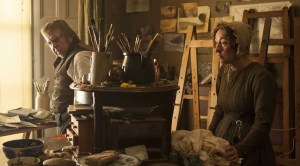
Pope shot the movie digitally, a decision based less on choice than circumstance – the closing of film labs in Britain as in the rest of the world. “All around us the celluloid infrastructure was collapsing and we would have been in terrible trouble shooting Mr. Turner on film when we did,” the DP observed.
Pope ended up embracing the new technology. He shot with two ARRI Alexa cameras. To soften the digital look he chose to go with old-fashioned Cooke Speed Panchro lenses. The state-of-the art digital cameras “give you the maximum detail in the image, the maximum latitude, the maximum range and I’m combining it with antique lenses that break down all that sharpness and give me the look of a period film,” he observed. “In the end the film looked neither like celluloid nor digital.”
Unbroken, Cinematographer Roger Deakins
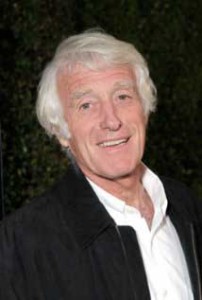
In Unbroken, director of photography Roger Deakins’ task was to combine a classic World War II film epic with a more personal story of a soldier’s heroic struggle to survive cruel torture at a series of Japanese prisoner-of-war camps. Directed by Angelina Jolie, the movie is based on the true story of Louis Zamperini, a runner in the 1936 Berlin Olympics who went on to serve as a bomber pilot and was shot down over the Pacific, got stranded for weeks in a raft, only to be captured by the Japanese.
Making the movie, shot on location in Australia, the DP and the director faced the challenge of keeping the film integrated throughout its many episodes. “The film feels epic but it’s actually a small film in a way. It didn’t have a huge budget and it basically all revolves around this one character, Zamperini,” noted Deakins. “The game plan was to keep the focus on this guy and all he went through.”
One early high point comes when Zamperini is engaged in a tense air fight that ends with his plane plunging into the wide-open Pacific. While there’s some impressive external footage, the scene mostly takes place in the big glassed-in cockpit of a B-24. “We felt it was important to be with the character and show what it would be like and feel like to be inside the plane, not make it into a videogame of planes flying at each other.”
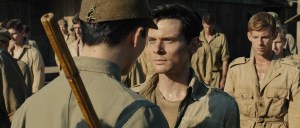
A full-size version of the airplane along with a separate construction of the fuselage and cockpit of the aircraft were used as sets. “Both were on gimbals suspended in the air so we could look down through the bomb bay doors and the fuselage,” said the DP. “We had to have the two plane replicas quite a way off the ground to get those shots.”
A powerful drama unfolds toward the end of the movie. As punishment, Zamperini is made to lift an enormous heavy plank over his head, in a visual that has Christ-like resonances. For Deakins getting the angle of the sun correct to create the proper lighting effect was his goal. “The trick was gauging the travel of light during the shot,” he noted. “I wanted Louie holding the plank looking into the sun as it is setting, and the sun showing up in his face. We’d set up the location, and when the angle of the sun hit the right angle of light, I’d start to shoot.”
The Grand Budapest Hotel, Cinematographer Robert Yeoman
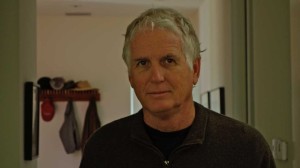
Robert Yeoman, the director of photography for The Grand Budapest Hotel – a sophisticated and richly comic caper along the lines of 1930s madcap movies – has been director Wes Anderson’s cinematographer of choice for nearly two decades. So he’s quite familiar with Anderson’s stylistic flourishes.
Anderson came up with the idea of filming in three screen formats that would evoke different projection styles from the past. Influenced by the look of movies of the 1930s, Yeoman shot scenes from that period in 1.33 aspect ratio. For the 1970s-80s he employed a wide-screen anamorphic look that was popular in films made then. And for the scenes set in the recent past he used 1.85 which is common for many of today’s films. The DP shot with an Arricam Studio film camera, using Cooke and Angenieux Optimo-Prime lenses.
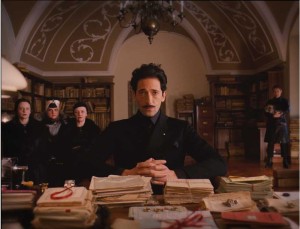
“As always Wes pushes us on all fronts,” said Yeoman. “He came up with a few shots that required me to ratchet up several gears, and the whip pans are always a challenge.” A project with Anderson begins with a long prep. “It’s a much more extensive preparation than any other director I’ve worked with,” said the DP.
The movie was filmed in mid-winter in Görlitz, a perfectly preserved town in the far east of Germany near the Polish and Czech border. A dilapidated old department store was converted into the Grand Budapest. The former emporium had a big skylight. But the quality of the light was poor and the short winter days provided only about 8 hours in which to film. Yeoman’s solution was to put lights on the roof, stretching a muslin material across the skylight to form a kind of cloud and then bouncing light through it. “That let us to shoot as long and whenever we wanted,” he noted.
One of the director’s charming eccentricities is his extensive use of compositions that are framed dead-center. “I often get to the set a little before Wes to put the camera completely in the center and sometimes the camera assistants tape out the edges of the matte box to the walls to make sure we are precise,” explained the DP. “One of the first questions Wes asks when he comes in is ‘Are we dead center?’ and I can say ‘yes, we are.’”
Ida, Cinematographers Ryszard Lenczewski and Lucasz Zal
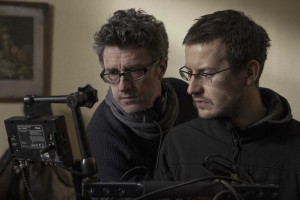
Ida, the stark black-and-white Polish movie that has also been nominated for the best foreign film Oscar, has two directors of photography that are both up for the Academy Award for best cinematography. Ryszard Lenczewski started shooting the film but after 10 days got seriously ill and handed off as cinematographer to Lucasz Zal, the film’s camera operator, who then lensed the rest of the movie.
Both contributed to Ida’s beautifully austere, introspective look – strikingly framed shots and minimal camera movement to capture the movie’s brooding intensity. Directed by Pawel Pawlikowski, Ida takes place in 1960s Communist Poland and tells the story of a young novitiate who, just before becoming a nun, is told by her wayward aunt that she is Jewish and that her parents were killed in the war and lie in unmarked graves.
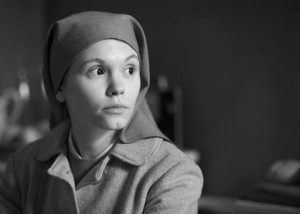
Lenczewski spent six months preparing for the shoot by taking 3,000 still photographs and many ended up almost exactly duplicated in the film. “For many years, the way I’ve prepared for a film as a creative cinematographer was to shoot photographs,” he said. “I note the moods of the places I visit, the lighting and the atmosphere, and I look for a different ways of framing. This is my first artistic impression, and the way I help create the style of the film.”
The idea to make the film in black and white and in a classic 4:3 aspect ratio was decided before Zal took the reins. He worked closely with the director on lighting and framing during the shoot. Though the film invokes black-and-white classics of an earlier era, it was created using the latest camera techniques. Ida was actually shot in color with a digital ARRI Alexa, using ARRI/Zeiss Ultra Prime lenses. Then it was converted into black and white in postproduction.





